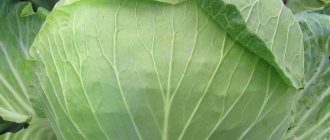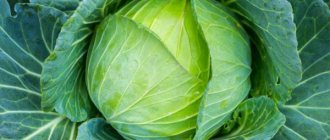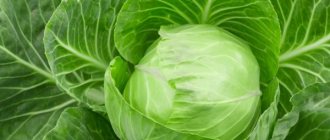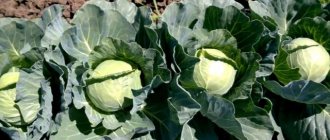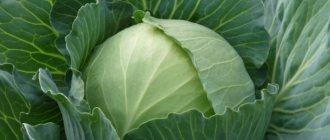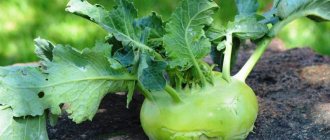Description of cabbage Sugarloaf
The variety has been zoned for the West Siberian region. However, according to reviews and supporting photos from vegetable growers, Sugarloaf cabbage has taken root well in the middle zone. Today, land owners are increasingly paying attention to Siberian cold-resistant varieties. This is due to climate change. And in the Moscow region, recurring night frosts are not uncommon at the end of May, or even at the beginning of June.
According to the description of the Sugarloaf cabbage variety and its photos taken by vegetable growers, the plant forms a powerful leaf rosette up to 40 cm high and up to 80 cm in diameter. The outer leaves are large, round, and somewhat loose. The head of cabbage is not completely covered. The color of the outer leaf blades is rich, green. However, from a distance they appear gray due to a strong waxy coating.
The inner leaves are much denser, with a slightly wrinkled surface and a wavy edge. Their color is light green. The plaque is weakly expressed. The leaf blades are fleshy and juicy, tightly adjacent to each other. Forks have a regular, round shape. Sometimes you come across flat-rounded specimens. The average weight of cabbage heads is 2.5-3.5 kg. The outer stalk is large, the inner one is small and rarely reaches a length of 7 cm.
Opinions about the taste of Sugarloaf cabbage are positive. Most often they are rated as good and excellent. The cabbage is sweet, juicy with increased crunchiness.
Interesting fact!
Heads of Sugarloaf cabbage are not afraid of early frosts. On the contrary, many experienced vegetable growers prefer to remove it after the plantings have been exposed to light frosts. According to them, in this case, a large amount of sugar accumulates in the leaves. The main thing is not to overdo it and not leave cabbage on the field when the frost is 10-15 degrees.
In addition, white cabbage Sugarloaf is undemanding to the composition of the soil and has a high immunity to diseases, which makes care much easier. For active growth and improved taste, it is necessary to ensure good lighting of the area and timely watering.
Positive and negative sides
This variety has been cultivated for quite a long time. Many years of experience have allowed us to identify its main advantages. It is thanks to them that this cabbage is widespread throughout the Russian Federation:
- Due to the fact that it is “Siberian”, it is highly resistant to frost. Moreover, it is even advisable to collect Sugar Loaf after several night frosts. This will increase the amount of sugar in the heads and make the vegetable even tastier. But at the same time it will slightly reduce the shelf life of the heads of cabbage.
- The culture has good immunity. As noted earlier, it is not afraid of diseases such as clubroot (a disease that can wipe out the entire crop), fusarium and vascular bacteriosis (which can significantly reduce the storage time of heads of cabbage).
- This is a drought-resistant variety that does not stop its growing season during short-term droughts.
- This variety is stored for a very long time, which many competitor varieties cannot boast of. For example, under favorable storage conditions, a head of cabbage can last even until May. Moreover, the longer we store the fruit, the sweeter it becomes.
- Cabbage is ideal for pickling.
- Has high productivity. In favorable conditions, you can collect about 55 tons from 1 hectare of plantings. On average, even an inexperienced gardener can easily collect up to 40 tons of quality products.
- Contains a large amount of sugar.
- It is not afraid of mechanical stress and can be transported painlessly over long distances.
- It has a good presentation, thanks to which the heads of cabbage are quickly sold out on the market.
At the same time, it is worth noting the negative aspects of Sugar Loaf:
- Heads of cabbage are prone to cracking. The tendency is innate and is not caused by “overexposure” on the site, as happens with other varieties.
- The “Head” rosette is quite voluminous, which is why the crop requires a lot of space for its cultivation. If cabbage is grown commercially, this is a serious disadvantage.
- Despite its strong immunity and resistance to a number of “cabbage” diseases, the crop cannot resist such a parasite as the cruciferous flea beetle.
Characteristics of the cabbage variety Sugarloaf
It is not without reason that Sugarloaf cabbage can be grown in the harsh Siberian climate. This is a surprisingly frost-resistant and cold-resistant variety. Its young shoots are able to withstand return frosts of up to 3-5 degrees.
She does not stop pouring heads of cabbage even when cold and rainy weather sets in. In the autumn, it can also ripen on the vine. Slight night frosts will not affect the duration of its storage.
The Sugarloaf cabbage variety is considered to be relatively drought-resistant. The heads of cabbage will not die with a short-term lack of moisture, but the taste of the cabbage may deteriorate. In particular, the juiciness of its leaves decreases. Uneven watering of cabbage during the growing season increases its tendency to crack. The variety is also resistant to premature flowering.
According to the characteristics, Sugarloaf cabbage is a late-ripening, productive variety. It reaches biological maturity 150-160 days after emergence. The harvest collected at this time can be stored for 6-8 months if favorable conditions are created. Namely, if you select strong, dense heads of cabbage for storage, without cracks or other external damage, and place them in a cool room with good ventilation. Also, this cabbage can be transported over long distances.
Attention!
It is worth noting that the Sugar Queen F and Sugar F1 varieties have recently appeared on the market. Unlike SG, they are hybrid. The first is distinguished by earlier ripening periods (120-150 days). The second one sets heads of cabbage well in dry weather. However, both varieties of cabbage are inferior to SG in taste.
The yield of cabbage Sugarloaf is 400-550 c/ha. It can be increased only by increasing the yield of marketable vegetables. It is only 93% mainly due to its tendency to crack. Timely and regular watering and careful attitude to the application of organic fertilizers will help to avoid this.
Cabbage is versatile in use. It can be fermented and pickled. And of course, use it fresh for preparing salads, first courses and side dishes.
Harvesting and storage
The ripening of heads of cabbage begins in August, and in September it proceeds at a more intense pace. Finally ripened cabbage is harvested in mid-October. Cutting heads of cabbage in cold, dry weather
It is important to do this before frost
After cutting, the head of cabbage is cleaned, leaving 2-3 outer leaves. Vegetables dried under a canopy and sorted, without signs of damage by diseases and pests, are placed in the storage area.
For long-term storage, choose the densest specimens weighing 2-3 kg, the length of the stump is at least 2 cm. Heads of cabbage with roots suspended from the ceiling of the storage facility are well preserved.
Early varieties, the ripening period of which is less than 70-100 days, are not suitable for long-term storage. They are intended for summer and autumn consumption. They are stored for no more than 3 months. Medium (120-150 days) and late-ripening (150-180 days) varieties can be stored until spring, and sometimes until summer, without any losses.
Planting and caring for Sugarloaf cabbage
It is impossible to grow a full-fledged crop of Sugarloaf cabbage in the middle zone, and especially in Siberia, without seedlings. Sowing in the ground is possible only in the southern regions, where by the beginning of May the air warms up to 15-18 degrees Celsius.
Growing seedlings
But there is also good news. Due to their frost resistance, Sugarloaf cabbage seeds can be planted in greenhouses and greenhouses, as well as under temporary shelters, starting from mid-April.
This will free the window sills from unnecessary containers and avoid such unpleasant procedures as additional lighting and hardening of seedlings.
For seedlings, Sugarloaf cabbage is planted in large containers or directly into the ground in greenhouses. It is first mixed with compost or humus. If necessary, add sand or peat as a leavening agent.
Cabbage seeds are sown on moist soil in increments of 3*5 cm. It is not worth sowing more often. The variety has good germination, so the seed does not require additional preparation.
With the emergence of seedlings, the seedlings are watered, the soil is periodically loosened, and fed with fertilizers such as “Kornevin” or “Zircon”. When grown at home, provide additional lighting. If necessary, plantings are thinned out, leaving at least 4-5 cm between shoots.
Transplantation into the ground
To grow Sugarloaf cabbage, choose well-lit places. However, you should not plant it on the southern slopes. Sunlight shining on the beds throughout the day can slow down the formation of heads and their filling.
In terms of soil composition, Sugarloaf prefers areas with loose and fertile soils. You should not plant cabbage two years in a row in the same place, or after other cruciferous vegetables. The main thing is that the soil is well drained and the area is not swampy.
Features of agricultural technology
The sugar cabbage variety is grown by seedlings and direct sowing of seeds in open ground. The first method is applicable in the regions of the middle zone. The crop is demanding on the composition of the soil. The soil must be nutritious with a neutral or alkaline reaction. Cabbage responds well to fertilizing and needs regular watering. Reviews indicate that plants are attacked by aphids and caterpillars, so it is important to pay attention to preventing pest attacks.
Growing cabbage seedlings Sugarloaf
Sowing seeds for seedlings is usually done in the first or second ten days of April. You will need a seedling box or separate containers with perforations at the bottom to drain excess moisture. The container is filled with soil prepared from components taken in equal proportions:
- turf;
- humus;
- sand;
- compost.
Attention! Stove ash is added to the soil mixture, and then it is disinfected in any way - by heating in the oven or using a pink solution of potassium permanganate.
Planting material also needs to be prepared for sowing. Seeds are calibrated in a saline solution, selecting the most promising ones - heavy and large. Then they are soaked in a solution of Fitosporin, and then in hot water (50 degrees) for 20 minutes and cooled.
Sowing is done in a moist substrate, in shallow furrows located at a distance of 5 cm from each other in increments of 3 cm. The box is covered with film, which is removed after germination. Seedlings are protected from direct sunlight, otherwise they will die.
The box with seedlings is left in a room where the thermometer does not rise above +15 degrees. Seedlings should receive plenty of light. Its deficiency leads to lengthening of the stems. The soil is moistened every 3 days, preventing it from drying out and forming a dense crust on the surface.
Attention! Too frequent and abundant watering is harmful to seedlings - it leads to the development of blackleg disease and plant death.
2 weeks after the emergence of seedlings, seedlings are picked if the sowing was done in a common container. Strong and developed plants are transferred to separate cups. It is best to use peat ones, since in the future you will not have to disturb the cabbage root system again when transplanting into the ground. Sugarloaf cabbage seedlings need to be fed with complex mineral fertilizer when 3 leaves form on the stems. 2 weeks before planting in the garden, the plants begin to gradually adapt to external conditions, leaving the containers in the fresh air.
Cabbage seedlings
Transplanting plants into open ground
At the end of May or beginning of June, seedlings are ready to be transplanted into the garden if they have reached 20 cm in length and 5 leaves have developed on the stems. The bed is dug up, loosened and holes are made according to a pattern of 60x80 cm, since the Sugarloaf cabbage forms wide spreading rosettes.
A teaspoon of urea, 15–20 g of superphosphate and a couple of handfuls of ash are poured into each hole. Fertilizers are mixed with soil, after which the holes are well shed with water. The seedlings are deepened to the level of the lower leaves. The soil around and the plants themselves are sprinkled with wood ash to protect them from insects that have already awakened from their winter sleep.
Caring for outdoor crops
Sugarloaf is demanding when it comes to watering. In the first days after transplantation, the bed is moistened daily if there is no natural precipitation. Subsequently, the plants are watered once every 6–7 days, pouring 6–8 liters of water under each bush. The next day, the soil is loosened and weeds are removed.
Hilling is carried out twice per season or as needed. This is done for the first time 3 weeks after planting the seedlings in the garden. The procedure is aimed at maintaining the still thin stem and stimulating the development of a powerful root system. When the heads are set, the Sugarloaf cabbage is spud again. The ridges should rise no more than 30 cm.
The crop needs feeding 3-4 times per season:
- In the first half of the growing season, an infusion of bird droppings diluted with water and a complex fertilizer with minerals are added twice, with an interval of 2–3 weeks.
- The third feeding is necessary during the formation of head buds. At this time, an increased dose of phosphorus and potassium is added, and nitrogenous fertilizers are not used.
- The fourth feeding is aimed at improving shelf life. It is recommended to carry it out 2 weeks before harvesting. At this stage, potassium fertilizers are used.
Attention! Cabbage will not crack if you reduce watering to a minimum 3-4 weeks before the start of harvesting.
Possible diseases and pests of the variety
The Sugarloaf cabbage variety is resistant to some diseases - clubroot, mucous and vascular bacteriosis and fusarium, as evidenced by reviews from gardeners and as stated by the manufacturer. However, this does not mean that you can neglect preventive measures to protect against diseases. These include:
- pre-sowing treatment of planting material and soil for seedlings;
- timely removal of plant residues from the garden in the fall;
- compliance with crop rotation recommendations;
- pest control.
This variety of cabbage is subject to attacks by insects - aphids, whiteflies, bedbugs and flea beetles, as well as caterpillars, all of which are carriers of infections.
Aphids on cabbage
Immediately after planting seedlings in the garden, you need to take measures to protect against pests. To do this, the soil and bushes are dusted with ash. You can prepare liquid formulations for spraying plants based on natural ingredients that repel insects, for example:
- vinegar or ammonia solution;
- soap-ash solution;
- garlic infusion;
- decoction of valerian roots with tobacco leaves.
Attention! If pests have already settled in the cabbage bed, you should resort to the help of biological or chemical insecticides. The latter drugs take a long time to be removed from plant cells, so they are not used at the final stage of the growing season.
Harvest dates
Sugarloaf cabbage is harvested from the garden in October, 130–145 days after emergence. Gardeners who have experience growing it advise waiting until the first frost. Cold promotes the accumulation of sugars, which makes this variety even tastier and juicier.
Store the heads of cabbage in a well-ventilated cellar at a temperature of 0...+5 degrees and a humidity of about 95%. The heads are carefully inspected for damage and placed with a poker in the sand or suspended. The main thing is that they do not touch each other.
Rules of care
Caring for Sugarloaf cabbage is no more difficult than planting it:
- Regular and even watering throughout the growing season.
- Feeding mainly with complex fertilizers containing nitrogen compounds.
- Weeding and loosening the soil.
Attention!
Watering should be regular, but not frequent and abundant. Otherwise, the percentage of marketable product yield decreases. Overuse of organic fertilizers also leads to cracking of forks.
Diseases and pests
Sugarloaf cabbage is resistant to diseases, but still insufficient care of plants can provoke the occurrence of some diseases. Among the most common are the following:
- Bacteriosis. There is yellowing of the outer parts of the leaves with further darkening and falling off. To prevent such a disease, use high-quality seed material, observe the necessary crop rotation, and carry out prophylaxis with Fitolavin. If an infection has already occurred, Planriza will help.
- Downy mildew. A white coating appears on the surface of the leaves. As a preventive measure: on the eve of sowing, the seeds are kept in warm water for 25 minutes, the plants are healed with ammonium nitrate. When the disease spreads, spraying with a solution of copper sulfate helps.
- Cabbage butterfly. Infected leaves turn pale and plants die over time. Sowing dill and parsley near the cabbage bed significantly reduces the likelihood of the disease spreading.
- Fusarium. When infected, yellow spots appear on the leaves. In order to prevent the disease, it is recommended to treat the crop with copper sulfate or a special agent “Agate”. Affected plants should be removed from the garden immediately.
- Kila. Occurs when a pathogenic fungus appears. Subsequently, the growth of the crop slows down or stops, and sometimes the plants die. Liming the soil, maintaining proper crop rotation, and treating with potassium permanganate on the eve of planting will help prevent the spread of the fungus. Infected cabbage specimens must be destroyed.
The most dangerous pests for Sugarloaf cabbage:
- Aphid. Usually sticks to the sheets from the reverse side. High activity of aphids is observed at the end of the summer and throughout the autumn.
- Cruciferous bugs. They spread over the surface of cabbage leaves and feed on its juices.
- Thrips. They cannot be seen with the naked eye. If charged, the plant loses color and soon dies.
Effective insect control products:
- "Iskra M"
- "Fury";
- "Bankol."
They are also used for spraying the soil around plants.
Attention! Careful adherence to crop rotation and timely removal of weeds significantly reduces the likelihood of diseases and attacks by harmful insects.
Reviews from gardeners about the cabbage variety Sugarloaf
Olesya, 32 years old, Tomsk In our area it is difficult to find cabbage that will have a late ripening period, excellent taste, and will be stored for a long time. Sugarloaf meets all three requirements. And most importantly - not too whimsical. There are cracked heads of cabbage. I let them pickle.
Nina, 40 years old, Smolensk I liked Sugarloaf for its excellent taste. Juicy and sweet. It is quite suitable for our latitudes. Not afraid of late frosts and summer heat. If it took up less space, it would be an ideal late look for storage.
Recommended for cultivation in Siberia and the Urals
Cabbage has been grown in summer in northern latitudes since time immemorial. New varieties specially bred for this region tolerate frost well, rarely get sick, grow quickly, and ripen smoothly.
Junior F1
Hybrid crop with excellent frost resistance. The cabbage rosette is slightly raised. A ripe vegetable has a white center. The head of cabbage is plump. The weight of the vegetable is 2 kilograms. Medium early culture. It is advisable to use for making salads.
Polar region F1
Hybrid cabbage with early ripening. Vegetables ripen 45 days after planting the seedlings. The round heads weigh 1.5 kilograms. Frost-resistant crop with sweet juicy heads of cabbage.
Florin
The culture is medium late. Grown for pickling and preparing fresh salads. Ripe heads are round, with a dense structure, white in cross section. The weight of one vegetable is 3-4 kilograms. The culture does not crack and rarely gets sick. Picked vegetables can be stored for 7 months.
Siberian 60
A variety bred for Siberia. The culture is resistant to low temperatures. Ripens 140 days after the first shoots appear. The heads do not crack; after harvesting, they are stored without spoiling for almost 4 months. The average weight of one vegetable is 4 kilograms. The head when cut is plump and white. The variety can be fermented for the winter or prepared for fresh salads.
Orion F1
Late ripening hybrid. Heads of cabbage ripen at 160 days. The culture loves sandy or loamy soil. The plant has a compact, vertically growing rosette. The head is round, plump, weighing 2.3 kilograms. The heads of cabbage do not crack and rarely suffer from bacteriosis and fusarium wilt.
Precocious
An early ripening crop, bred back in 1973. Cabbage ripens 55 days after planting the seedlings. The cabbage rosette is small, with raised leaves. The weight of one vegetable is 1.3 kilograms. Cabbage often cracks. Grown for making fresh salads.
Polar K-206
The variety was bred back in 1950. This is a mid-early culture. Grown for fresh consumption and pickling. Cabbage rosettes are medium, with a diameter of 80 centimeters. The heads of cabbage are round, of medium size, dense and uniform in the middle. Heads of cabbage can crack, develop clubroot and bacteriosis.
Advantages and disadvantages
The Amager cabbage variety has many advantages, thanks to which it competes well with modern hybrid varieties:
- Frost resistance. Cabbage seedlings can withstand frosts down to -5°C.
- Long-term storage – 7-8 months.
- High transportability.
- Resistant to cracking.
- Harvest stability, uniform ripening.
- Possibility of growing in the northern regions of Russia.
The disadvantages of this variety include:
- Has weak immunity. Not resistant to diseases: fusarium wilt and vascular bacteriosis. During storage, it is susceptible to gray rot and spot necrosis.
- When the air temperature is more than +250C (over 8-10 days) or there is no watering, it stops growing.
- With a lack of sunlight, small leaves and loose heads of cabbage are formed.
- When it reaches ripeness, the head of cabbage has a bitter taste, which disappears with time of storage.
Advice
Compliance with the rules of agricultural technology will minimize deficiencies and get a good harvest.
Advantages and disadvantages
Like any variety, Stone Head has its advantages and disadvantages. It is hardly correct to call them that, because what would be a disadvantage for one gardener will be the main advantage for another. However, let's discuss them:
- Cabbage is versatile in cooking, but is especially good for winter preparations. There are few such varieties.
- The longer Stone Head is stored, the better it tastes, even when fresh.
- The heads of cabbage have a dense structure and do not fall apart.
- Does not crack during ripening, even if the weather is rainy.
- It tolerates frost quite well, and drought even better.
- The leaves are often described as harsh and dry.
Preparing the soil and growing seedlings
The crop is grown through seedlings. Sowing seeds of late-ripening varieties is best done in early to mid-April. Place the seedlings on the windowsill or sow directly into open ground under a film. The soil for seed germination should warm up to 15-17 degrees, the sowing density should be 5x5 cm. Before sowing, the seeds should be soaked for 12 hours in a solution of potassium humate, then washed and slightly dried.
Treatment of cabbage seeds before planting
The soil should be well fertilized with humus, urea, and potassium fertilizers. To grow seedlings at home, you can prepare containers with special mixtures:
- 20-25% turf soil, 70% peat, 5% sand;
- half of the composition is turf, up to 45% humus, 5% sand.
Seedlings are planted in open soil after the appearance of 4 leaves, approximately at the end of May - beginning of June.
